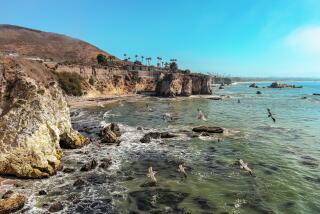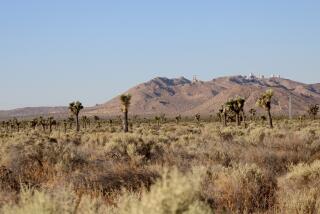Mexico Deep-Sixes Plan for Baja Lagoon Saltworks
- Share via
MEXICO CITY — After a ferocious five-year battle that drew in environmentalists, a Nobel Prize winner and Hollywood stars, the Mexican government and Mitsubishi Corp. announced Thursday that they were canceling plans for a giant saltworks in Baja California Sur.
In a surprise announcement, President Ernesto Zedillo said the government had withdrawn its support from the venture because it would alter the stunning landscape of arid desert. The nearby seas offer the last pristine breeding refuge of gray whales that migrate annually between Mexico and Alaska.
“This is a place that has had minimum interference by humans--one of the few places like that left on the planet,” he said.
The government had viewed the project as a chance to create jobs in the remote, impoverished area. But the perceived threat to the whales had turned the proposal into a cause celebre.
In recent months, Los Angeles and other cities had joined the California Coastal Commission in passing resolutions against construction of the salt plant. Mitsubishi had come under attack in an international campaign of ads, boycotts and disinvestment initiatives. It received 700,000 postcards, most from the U.S., opposing the project at the San Ignacio Lagoon, about 450 miles from San Diego down the Baja California peninsula.
International nature groups, famed writers such as Portuguese Nobel laureate Jose Saramago, actors such as Pierce Brosnan and social activists such as Robert F. Kennedy Jr. joined the cause.
“This is the first time in Mexico that this kind of mobilization has managed to affect a project this large,” said Ari Hershowitz, a Los Angeles-based staffer of the Natural Resources Defense Council, which opposed the project.
Environmentalists were jubilant. “For us, this is not just an ecological victory but a spiritual one,” said Homero Aridjis, the head of the Group of 100, a Mexican environmental organization that spearheaded the coalition against the plant.
“There are values that you can’t trade,” he said. “It would be like, in human terms, trading the Sistine Chapel for sea salt.”
The decision to cancel the 75,000-acre saltworks took environmentalists by surprise. They had been expecting the Exportadora de Sal company--51% of which is owned by the Mexican government, 49% by Mitsubishi--to issue a long-delayed environmental impact study concerning the project in the next few weeks. A review process was scheduled to follow, with a government decision likely late in the year.
The government and Mitsubishi said Thursday that the environmental impact study had been completed and showed the plant would not damage the whales or other animals in the area of the 17-mile-long San Ignacio Lagoon. But they said they dropped the $180-million project because of concerns about changes it might bring to the region.
“What we would have done is flood salt flats. It wouldn’t look natural,” said James E. Brumm, a Mitsubishi executive vice president, at a news conference here. “We came to appreciate a number of arguments by people that this is an area that should be left as is for ecotourism.”
Brumm said the company sought to make its decision on scientific grounds, not public pressure. However, asked about the bad publicity, he said: “Certainly, it was something we didn’t like.”
What makes San Ignacio unique are the “friendly whales,” which at times nuzzle their bodies against ecotourist skiffs that troll the mouth of the lagoon on the Pacific coast of Baja California. Local residents say they first began touching the whales in 1972, and the mammals’ willingness to approach boats has grown ever since.
What’s more, the offspring of whales born in the lagoon during the winter breeding season also learn to be friendly--a far cry from the 19th century, when gray whales were called “devil-fish” for their fierce attacks on whalers.
In actions that won Mexico wide praise, the government in the 1970s designated San Ignacio Lagoon and--about 100 miles to the north--Ojo de Liebre Lagoon as whale refuges. Both were included within the Vizcaino Biosphere Reserve that was created in 1988. The decree stipulated that economic development within the 6-million-acre reserve should be ecologically compatible.
Opponents complained that the project would be built inside Latin America’s largest environmental reserve and beside the last undeveloped breeding ground of the gray whale. They feared that the plant would harm the whales’ “nursery” by pumping huge volumes of water from the shallow northern end of the lagoon near where the whales give birth.
The company responded that the seawater would be drawn through a 1.5-mile canal to avoid any disruptions to the lagoon. It said electric pumps would cut down on noise and pollution.
The company made extensive changes to its plans for the saltworks after Mexican environmental officials turned down an earlier plan in 1994. The changes raised the project cost by $60 million.
The plant, scheduled to be fully operational in 2010, would have provided 216 jobs and sales of about $100 million a year, Mitsubishi’s Brumm said.
He said the company began to turn against the project after a study by UNESCO late last year that questioned changing the landscape of the area around San Ignacio Lagoon. He said Mexican Commerce Minister Herminio Blanco met a few weeks ago with Mitsubishi officials in Japan to discuss the project.
Environmentalists weren’t the only ones cheered by the cancellation.
The fishermen of Punta Abreojos, a tiny Pacific Coast town 45 miles west of the San Ignacio Lagoon, expressed delight at Zedillo’s decision.
“This is perfect, the best news we could have hoped for,” Antonio Zuniga, secretary of the town fishing cooperative, said in a phone interview. The cooperative had worried that its rich catches of rock lobster, abalone and ocean fish would have been disrupted by the project.
More to Read
Sign up for Essential California
The most important California stories and recommendations in your inbox every morning.
You may occasionally receive promotional content from the Los Angeles Times.










